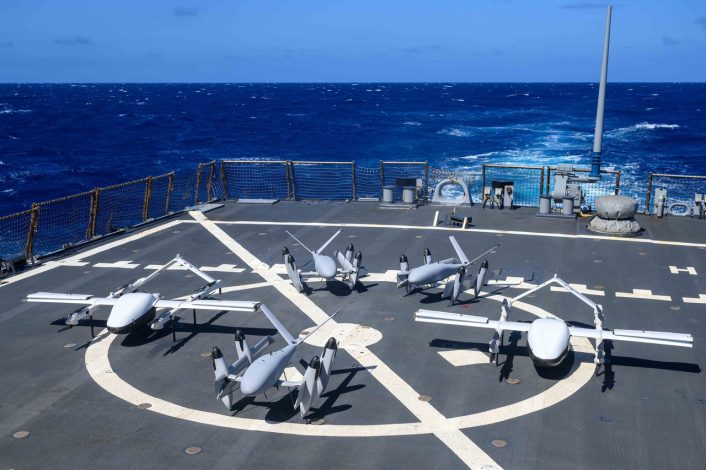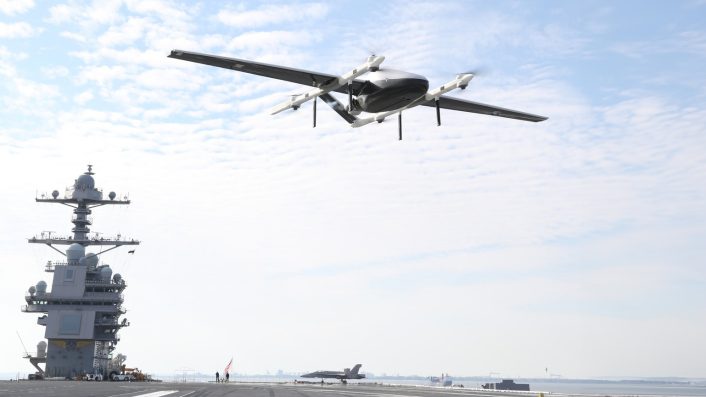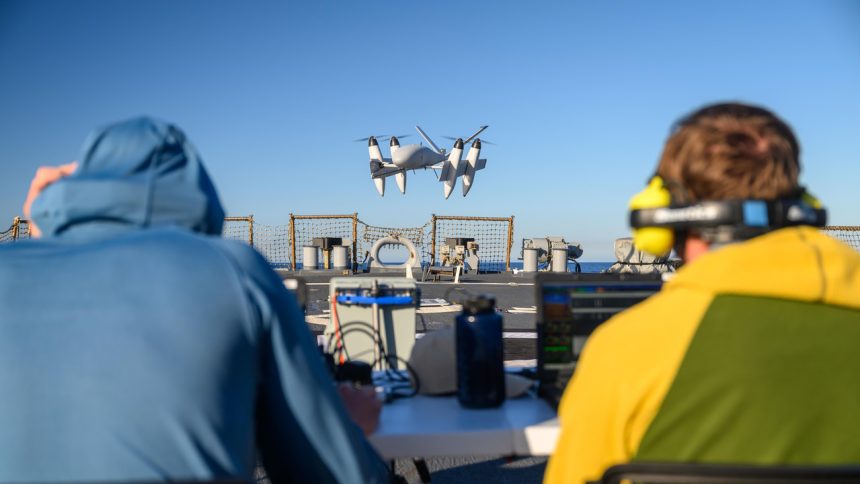The responsibility of ferrying small cargo between ships falls on large aircraft like the MH-60 helicopter or the V-22 Osprey
The RIMPAC (Rim of the Pacific) exercise this year saw U.S. Navy guided-missile destroyer USS Curtis Wilbur “experiment” with UAVs (Unmanned Aerial Vehicles) transporting small and light cargo between ships during the drill’s Trident Warrior segment.
Three units of the X-P4 Transwing VTOL (Vertical Take-Off and Landing) from PteroDynamics and two of the V2.6 (also called the Blue Water Logistics UAS) from Skyways were photographed on the ship’s helicopter deck in the run up to the massive drills. Six drones were launched and recovered for validating their use in logistical roles of transporting small supplies between ships.
The USN has tested these UAVs before, for the same role, as far back as 2021, transporting small supplies like wirings and electrical components. This takes the load off larger manned systems like V-22 Osprey tiltrotors and MH-60 naval helicopters that are used to transport such disproportionately small, lightweight cargo.
RIMPAC, the world’s largest international maritime exercise, this year is seeing the participation of 29 nations and 40 surface ships, three submarines, 14 national land forces, more than 150 aircraft, and 25,000 personnel in and around the Hawaiian Islands from Jun. 27 to Aug. 1, 2024.

Drones for small ship-to-ship cargo
According to a statement by the Navy, the Arleigh Burke-class guided-missile destroyer USS Curtis Wilbur experimented with the launch and recovery of six unmanned aerial systems from Jun. 19 to Jun. 24. Deployed in support of the JITD (Just In Time Delivery) effort, the “aircraft are intended to perform ship-to-ship and ship-to-shore autonomous deliveries of medical supplies and critical parts,” said Edward Gesser, a JITD engineer from the Naval Air Warfare Center Aircraft Division (NAWCAD).
Traditionally, critical supplies needed by the Navy are delivered using manned aviation assets. “Due to the high costs and the lack of manned asset availability, a significant number of naval operations are delayed while waiting for critical supplies,” said Gesser. The JITD goal was to “demonstrate simulated long-range deliveries of critical parts and supplies via autonomous shipboard takeoffs and landings.”
The statement quoted the commanding officer, Cmdr Yilei Liu, who said the next step with the “easy to configure and ready to deploy” drones is to evaluate them in different environmental conditions to define the scope and operating envelope. The drones are described as “autonomous,” indicating they might be capable of flying between set waypoints and take off and landing automatically.
“Fleet experimentation allows the Navy and its partners to incorporate real-world warfighter feedback early in the acquisition process by exposing the Fleet to emerging capabilities,” said the statement about the reasons for the experiment initiatives during RIMPAC.
The activity was therefore a concept validation of sorts, with the two systems not actually being procured, but informing future system and performance requirements for cargo drones which would later be stipulated in RFI/RFPs (Request for Information/Request for Performance).
Transporting small goods is an elementary capability that can even be performed by off-the-shelf UAVs, but fleet experimentation in operational environments amid a massive exercise like RIMPAC would help shed more light on the operational and technical modalities. These include crew handling, familiarity, storage and special infrastructure that might be needed for their operation.
If we could sum up the Transwing in two words, it would be: Simply Revolutionary! #transwing #vtol #aerospace #pterodynamics pic.twitter.com/qbe0a70t9b
— PteroDynamics Inc. (@pterodynamics) March 26, 2024
The drones
The electric Skyways V2.6 (or the Blue Water UAS) features four rotors surrounding a tear-shaped body with a pusher propeller for forward flight. It also sports folding wings and an inverted V-tail, and boasts a range of 500 mi (805 km) and a 30 lbs (13.6 kg) payload. Interestingly, the manufacturer’s website mentions that the UAS can be recharged in flight and optionally operate in GPS-denied environments.
The PteroDynamics Transwing VTOL drone has an unique design, with the two wings, carrying two engines each (four engines in total), able to completely fold up and rotate to transform from a quadcopter configuration to a standard monoplane-shaped airplane. The company describes it as a “dihedrally-folding wing system.”
Previous experiments
In February 2021, USN planners “rushed” the Blue Water UAS to the deck of the USS Gerald R. Ford aircraft carrier while it was in Norfolk, Virginia, according to a USNI report in August that year. “Over two weeks in February, the system demonstrated its utility in quickly delivering small packages representing spare parts and other necessary supplies in a carrier environment aboard the Ford,” mentioned the report.

Then in July, it flew from the USS Bainbridge to the USNS Joshua Humphreys, rapidly progressing from the prototype phase to demonstrating ship-to-ship capability in nine months. Tony Schmidt, director of rapid prototyping, experimentation and demonstration at NAWCAD (Naval Air Warfare Center Aircraft Division), said the eventual Blue Water drone likely will not be the Skyways drone, but will be chosen based on requirements generated from testing that model.
This test was followed by the NAWCAD, the MSC (Military Sealift Command) and the U.S. Marine Corps on Jun. 12, 2023, successfully integrating “a logistics drone into a fleet exercise.” Two Blue Water drones performed five UAS test flights over a period of two days, flying “simulated resupply missions” from the fleet replenishment tanker USS Patuxent in the Atlantic Ocean to Marines ashore in North Carolina, “making multiple deliveries.” The “expeditionary material” was loaded into the Blue Water’s removable internal cargo bay.
Three of the flights demonstrated the UAS’s ability to deliver simulated critical repair parts autonomously from USNS Patuxent to Marines. The other two flights involved “successful autonomous flights transporting simulated cargo from the Marines ashore” to the Patuxent.
Why the U.S. Navy needs logistics drones
According to the Navy, 90% of the high priority parts delivered from MSC’s Combat Logistic Force ships weigh less than 50 lbs (22 kg). The ferry flight to move such small parts like electronics or wiring assemblies, usually falls to a manned platform like an MH-60 helicopter or a V-22 Osprey.
Instead of using a helicopter or sailing ships close together, the Navy can use a logistics drone, which “saves the wear and tear on helicopters.” “We want to develop a logistics UAS to get rid of the helos that transport parts back and forth,” Schmidt added in the USNI report.









